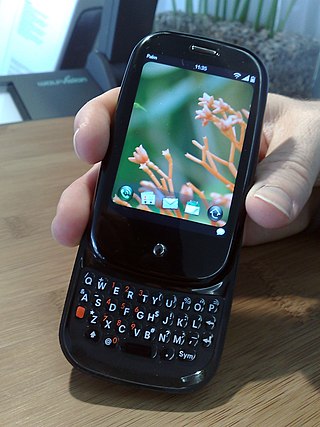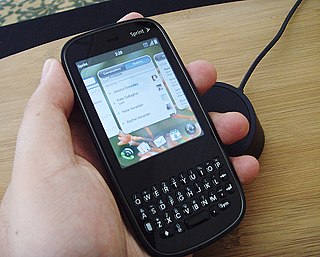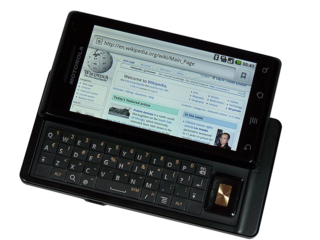
A personal digital assistant (PDA), also known as a handheld PC, is a multi-purpose mobile device which functions as a personal information manager. PDAs have been mostly displaced by the widespread adoption of highly capable smartphones, in particular those based on iOS and Android, and thus saw a rapid decline in use after 2007.

Palm OS was a mobile operating system initially developed by Palm, Inc., for personal digital assistants (PDAs) in 1996. Palm OS was designed for ease of use with a touchscreen-based graphical user interface. It was provided with a suite of basic applications for personal information management. Later versions of the OS were extended to support smartphones. The software appeared on the company's line of Palm devices while several other licensees have manufactured devices powered by Palm OS.

Palm, Inc., was an American company that specialized in manufacturing personal digital assistants (PDAs) and developing software. Palm designed the PalmPilot, the first PDA successfully marketed worldwide, and was known for the Treo 600, one of the earlier successful smartphones. Palm developed the Palm OS software for PDAs and smartphones released under its line of Palm-branded devices and also licensed to other PDA manufacturers.

Palm is a line of personal digital assistants (PDAs) and mobile phones developed by California-based Palm, Inc., originally called Palm Computing, Inc. Palm devices are often remembered as "the first wildly popular handheld computers," responsible for ushering in the smartphone era.

Windows Mobile is a discontinued mobile operating system developed by Microsoft for smartphones and personal digital assistants.

Jonathan J. "Jon" Rubinstein is an American electrical engineer who played an instrumental role in the development of the iMac and iPod, the portable music and video device first sold by Apple Computer Inc. in 2001. He left his position as senior vice president of Apple's iPod division on April 14, 2006.
Upstart is a discontinued event-based replacement for the traditional init daemon—the method by which several Unix-like computer operating systems perform tasks when the computer is started. It was written by Scott James Remnant, a former employee of Canonical Ltd. In 2014, Upstart was placed in maintenance mode, and other init daemons, such as systemd, were recommended in place of Upstart. Ubuntu moved away from Upstart with the release of version 15.04 in favor of migrating to systemd. As of March 2023, there have been no updates released for Upstart since September 2014.

The Palm Centro is a smartphone marketed by Palm, Inc. beginning its release on October 14, 2007, offering the functionality of the larger Treo 755p in a smaller size.
A mobile operating system is an operating system used for smartphones, tablets, smartwatches, smartglasses, or other non-laptop personal mobile computing devices. While computers such as typical/mobile laptops are "mobile", the operating systems used on them are generally not considered mobile, as they were originally designed for desktop computers that historically did not have or need specific mobile features. This line distinguishing mobile and other forms has become blurred in recent years, due to the fact that newer devices have become smaller and more mobile unlike hardware of the past. Key notabilities blurring this line are the introduction of tablet computers, light-weight laptops, and the hybridization of the two in 2-in-1 PCs.
Optware is a free software package manager for embedded systems. Originally developed as a distribution mechanism for the Unslung Linux distribution for the Linksys NSLU2, Optware has been adopted by a variety of hobbyist communities and device developers.

The Palm Pre, styled as palm prē, is a multitasking smartphone that was designed and marketed by Palm with a multi-touch screen and a sliding keyboard. The smartphone was the first to use Palm's Linux-based mobile operating system, webOS. The Pre functions as a camera phone and a portable media player, and has location and navigation capabilities. The Pre also serves as a personal information manager, has a number of communication and collaboration applications, and has Bluetooth and Wi-Fi connectivity built-in.

webOS, also known as LG webOS and previously known as Open webOS,HP webOS and Palm webOS, is a Linux kernel-based multitasking operating system for smart devices such as smart TVs that has also been used as a mobile operating system. Initially developed by Palm, Inc., HP made the platform open source, at which point it became Open webOS.

MiFi is a brand name to describe a wireless router that acts as a mobile Wi-Fi hotspot device.

The Palm Pixi and Pixi Plus are multimedia smartphones, developed by Palm, which was purchased in 2010 by HP. The device is viewed as a successor to the Palm Centro smartphone and was Palm's second webOS device, after the Palm Pre.

The Motorola Droid is an Internet and multimedia-enabled smartphone designed by Motorola, which runs Google's Android operating system. The Droid had been publicized under the codenames Sholes and Tao and the model number A855. In Latin America and Europe, the model number is A853 (Milestone), and in Mexico, the model number is A854 (Motoroi). Due to the ambiguity with newer phones with similar names, it is also commonly known as the DROID 1. The brand name Droid is a trademark of Lucasfilm licensed to Verizon Wireless.
The Palm Pre 2, styled as palm prē 2, is a slider smartphone designed and marketed by Palm, Inc., and Hewlett-Packard with a multi-touch screen and a physical sliding keyboard. The smartphone is the third to use Palm's Linux-based mobile operating system, webOS. The Pre 2 functions as a camera phone, a portable media player, and has location and navigation capabilities. The Pre also serves as a personal information manager, has a number of communication and collaboration applications, and has Bluetooth and Wi-Fi connectivity built-in.

The HP TouchPad is a tablet computer that was developed and designed by Hewlett-Packard. The HP TouchPad was launched on July 1, 2011, in the United States; July 15 in Canada, United Kingdom, France, Germany; and August 15 in Australia.

The Veer was a smartphone announced by HP on February 9, 2011. The device used HP webOS, was powered by a Qualcomm Snapdragon processor, and had a 2.6-inch screen. The device was notable for its credit card-sized dimensions. The device was seen as the successor in the Palm line-up to the Pixi and earlier Centro models.

The HP Pre 3, styled as Pre3, is a touchscreen slider smartphone manufactured by Hewlett-Packard. The device uses webOS, is powered by a Qualcomm Snapdragon processor, and has a 3.6-inch screen. It is conceptually the successor to the Palm Pre 2 and earlier Pre and Pre Plus models.













